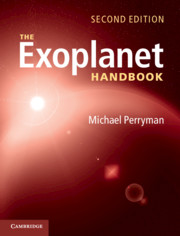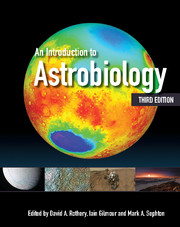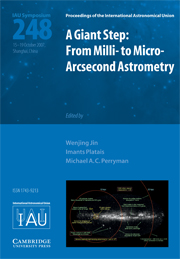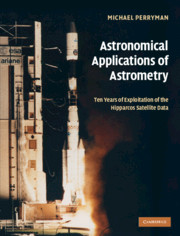The Exoplanet Handbook
2nd Edition
£72.99
- Author: Michael Perryman
- Date Published: August 2018
- availability: Available
- format: Hardback
- isbn: 9781108419772
£
72.99
Hardback
Other available formats:
eBook
Looking for an inspection copy?
This title is not currently available on inspection
-
With the discovery of planets beyond our solar system 25 years ago, exoplanet research has expanded dramatically, with new state-of-the-art ground-based and space-based missions dedicated to their discovery and characterisation. With more than 3,500 exoplanets now known, the complexity of the discovery techniques, observations and physical characterisation have grown exponentially. This Handbook ties all these avenues of research together across a broad range of exoplanet science. Planet formation, exoplanet interiors and atmospheres, and habitability are discussed, providing in-depth coverage of our knowledge to date. Comprehensively updated from the first edition, it includes instrumental and observational developments, in-depth treatment of the new Kepler mission results and hot Jupiter atmospheric studies, and major updates on models of exoplanet formation. With extensive references to the research literature and appendices covering all individual exoplanet discoveries, it is a valuable reference to this exciting field for both incoming and established researchers.
Read more- The first edition (2011) won the Association of American Publishers' PROSE Award for Cosmology and Astronomy
- The book is illustrated with more than 400 figures of important physics and phenomena at work
- An in-depth bibliography provides an entry point to detailed research literature
- Includes concise appendices with hyperlinks which provide scientific notes on each confirmed exoplanet
Reviews & endorsements
'The second edition of The Exoplanet Handbook is an extraordinary achievement. In a field that is progressing at a dizzying pace, Michael Perryman has carefully digested a huge volume of research and presented the reader with an accessible summary in a clear and authoritative style. Covering the whole exoplanet field, the handbook serves as a wonderful introduction to the student and a trusty companion to the experienced researcher. This is indispensable reading for anyone serious about exoplanets.' Peter Wheatley, University of Warwick
See more reviews'This is an impressively complete guide to all exoplanet-related research conducted to date. It is a must-have for any exoplanet researcher, from new undergraduate students to seasoned professors. This second edition of Perryman's handbook has more than doubled in size, and is a testimony to the many rapid developments in the field. It is by far the most comprehensive reference for exoplanet research available.' Ignas Snellen, Rijksuniversiteit Leiden, The Netherlands
'This is a new edition of Perryman's excellent Exoplanet Handbook which was published in 2011. The first edition quickly became a favourite with researchers: in my view this version will become the bible. The second edition is the same format as the original but contains more than twice as many pages … The first port of call when thinking about a new project. Perryman has painstakingly searched all the discovery and analysis techniques commonly used and presented his conclusions in a concise way whilst retaining sufficient detail to make them useful for research scientists … The breadth of work and Perryman's ability to digest the results and put it in context is just remarkable.' Don Pollacco, The Observatory
'This is now the bible of the field and should be on the bookshelf of everyone who wants to view our planet and its history from a more realistic perspective than the old anthropocentric. The breadth of the work is impressive, and Perryman covers in detail and authoritatively everything from the basics of the field, such as observational techniques, classification of the stars hosting the exoplanets, formation and evolution of the planets, and what we know about their interiors and atmospheres. … The content is encyclopedic, with many concepts explained in small text boxes or explanatory figures carefully chosen from the literature. But unlike an encyclopedia, the information appears in a meaningful context, not in alphabetical order … Everything is laid out in a very 'user-friendly' way.' Birger Schmitz, Meteoritics & Planetary Science
'This book is an abridgement of all things extrasolar planets. With a thorough revamp, it is now more than twice as long not counting the appendices where lists of extrasolar planets by methods of detection can be found; references that include back references i.e. where to find them in the text; subject index and object index. The meat of the book … is … a collection of papers that have been rewritten and reorganised in such a way to convey only the take-home messages … With thousands of papers on the subject, weeding out the best of them is no mean feat. … This is basically an encyclopaedia on extrasolar planets; useful to serious readers. Barring anything that happens after its publication, this book is up-to-date.' B. Ishak, Contemporary Physics
Praise for the first edition: '… more technically detailed and comprehensive than many of the rival texts … it is an ideal companion for a Ph.D. student in the field, as well as an excellent reference for the experienced researcher … this is also an excellent, detailed textbook suitable for a specialist undergraduate or postgraduate lecture course.' The Observatory
Praise for the first edition: 'If I were allowed access to only one book on the subject of extra-solar planets, Michael Perryman's The Exoplanet Handbook is a contender that would be very hard to beat. The book documents the whirlwind development of this newly emergent and energetic new field of science … It is also a compendium of essential physical concepts, useful formulae and computational strategies for analysis of the various types of astronomical data used to discover and characterise exoplanets.' Andrew Collier Cameron, University of St Andrews
Praise for the first edition: 'This remarkable compilation brings together observations and theoretical explorations of a rapidly growing astronomical field. Literally every possible observational method is explained and recent results given … While the number of known exoplanets changes weekly, the methods through which we discover and characterise these do not. Highly recommended.' George F. Benedict, University of Texas, Austin
Praise for the first edition: 'The Exoplanet Handbook provides a very valuable integration of all aspects of the fascinating and interdisciplinary world of exoplanet science. It combines in a coherent context the presentation of the observational techniques, covering recent highlights and future prospects, with the description of the vast range of intertwining phenomena and processes that shape the paths of planet formation, evolution and structure … The Handbook is an invaluable resource for professional planetary scientists and academic teachers, for both practising astronomers and motivated amateurs, and for advanced undergraduate and graduate students.' Vittorio Vanzani, Università degli Studi di Padova, Italy
Praise for the first edition: 'This Handbook is a true encyclopedic reference on exoplanets. Perryman's new book is a comprehensive review on major programs and results obtained in the last decade in this exciting new domain of astrophysics and as such it is a priceless resource for experts. The detailed descriptions of the foundations of the main observations techniques and key theoretical aspects make it a perfect book for any student wishing to have a comprehensive introduction to exoplanet research. This volume is likely to become an important reference in the field.' Didier Queloz, Geneva Observatory
Praise for the first edition: 'The Exoplanet Handbook by Michael Perryman is impressive; the content is of high level and very accurate. He has succeeded in providing an exhaustive and up-to-date review of this mature and rich field. The Handbook will surely help Ph.D. students and professional astronomers who want to learn about this field. It will even be useful to experts who want to check details on some specific aspects, either about exoplanets themselves, detection methods, or instrumentation.' Jean Schneider, CNRS/LUTH, Paris Observatory
Praise for the first edition: '… an excellent, startlingly complete snapshot of the current state of knowledge regarding extrasolar planets … Like any good encyclopedia, The Exoplanet Handbook has as its major strength its reference list, which cites more than 4000 papers. The list provides a near-complete snapshot of all the research that has taken place in the field in the past two decades. Furthermore, the references are deftly integrated into the text, which makes this volume an excellent point of departure for any researcher seeking to chart a new course of exoplanetary investigation.' Gregory Laughlin, Physics Today
Praise for the first edition: 'The Exoplanet Handbook by Michael Perryman is an exhaustive reference for the techniques, facts and theory of exoplanet science. An excellent and objective resource for novice and expert alike, this compendium is destined for the libraries of all serious students of the art.' Adam Burrows, Princeton University, New Jersey
Praise for the first edition: 'Perryman's book is truly a major achievement: it is an astonishingly complete overview of everything we know about exoplanets. The Exoplanet Handbook will serve as the seminal reference in this field for many years. I would (and will) strongly encourage any graduate students interested in doing serious research in exoplanets to buy a copy of this book.' B. Scott Gaudi, Ohio State University
Praise for the first edition: 'Michael Perryman's new book provides not only a thorough discussion of what we have learnt about extrasolar planets since the first discoveries over 15 years ago, but also a clear and comprehensive review of the wide range of observational and theoretical techniques that have been employed to find and characterise them. This volume is a must-have for serious researchers in the field, and will be an invaluable reference for many years to come.' I. Neill Reid, Space Telescope Science Institute
Customer reviews
Not yet reviewed
Be the first to review
Review was not posted due to profanity
×Product details
- Edition: 2nd Edition
- Date Published: August 2018
- format: Hardback
- isbn: 9781108419772
- length: 952 pages
- dimensions: 253 x 193 x 44 mm
- weight: 2.17kg
- availability: Available
Table of Contents
Preface
1. Introduction
2. Radial velocities
3. Astrometry
4. Timing
5. Microlensing
6. Transits
7. Imaging
8. Host stars
9. Brown dwarfs and free-floating planets
10. Formation and evolution
11. Interiors and atmospheres
12. The Solar System
Appendix A. Numerical quantities
Appendix B. Notation and acronyms
Appendix C. Radial velocity exoplanets
Appendix D. Transiting exoplanets
Appendix E. Lensing exoplanets
Appendix F. Imaging exoplanets
References
Subject index
Object index.-
Find resources associated with this title
Type Name Unlocked * Format Size Showing of
This title is supported by one or more locked resources. Access to locked resources is granted exclusively by Cambridge University Press to lecturers whose faculty status has been verified. To gain access to locked resources, lecturers should sign in to or register for a Cambridge user account.
Please use locked resources responsibly and exercise your professional discretion when choosing how you share these materials with your students. Other lecturers may wish to use locked resources for assessment purposes and their usefulness is undermined when the source files (for example, solution manuals or test banks) are shared online or via social networks.
Supplementary resources are subject to copyright. Lecturers are permitted to view, print or download these resources for use in their teaching, but may not change them or use them for commercial gain.
If you are having problems accessing these resources please contact [email protected].
Sorry, this resource is locked
Please register or sign in to request access. If you are having problems accessing these resources please email [email protected]
Register Sign in» Proceed
You are now leaving the Cambridge University Press website. Your eBook purchase and download will be completed by our partner www.ebooks.com. Please see the permission section of the www.ebooks.com catalogue page for details of the print & copy limits on our eBooks.
Continue ×Are you sure you want to delete your account?
This cannot be undone.
Thank you for your feedback which will help us improve our service.
If you requested a response, we will make sure to get back to you shortly.
×





